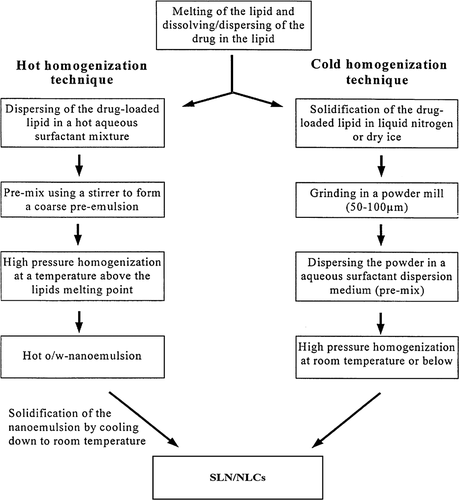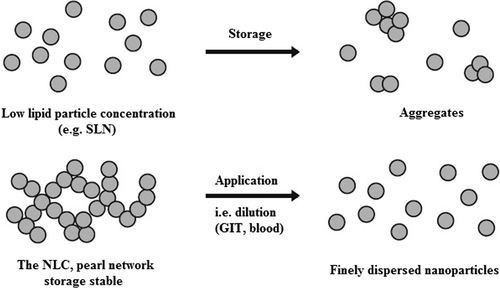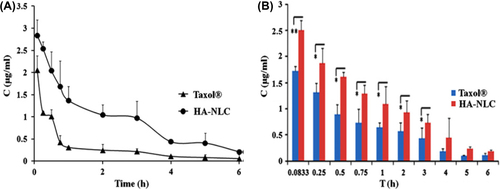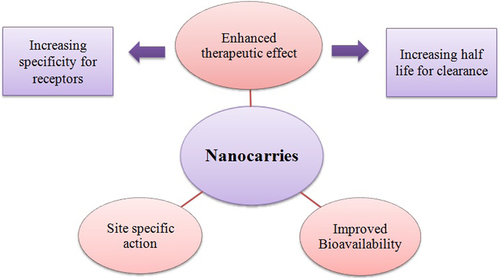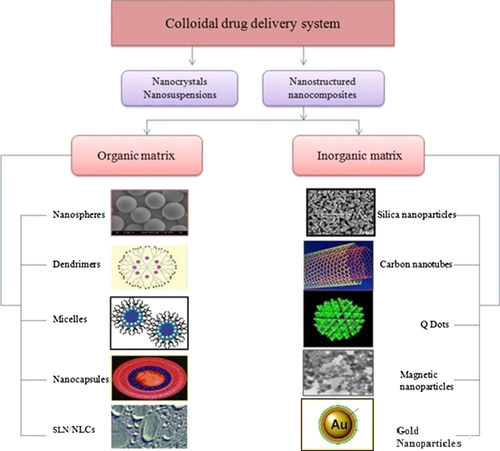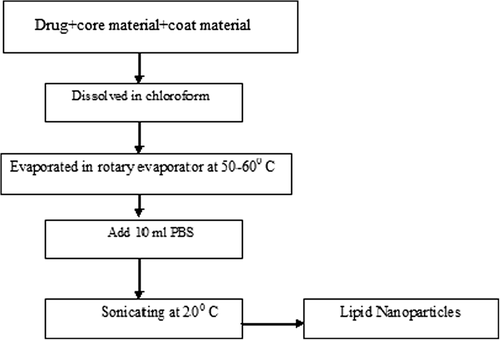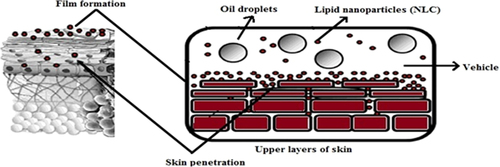Figures & data
Westesen K, Bunjes H, Koch MHJ. 1997. Physicochemical characterisation of lipid nanoparticles and evaluation of their drug loading capacity and sustained release potential. J Control Release. 48:223–236. Mehnert W, Mäder K. 2001. Solid lipid nanoparticles: production, characterization and applications. Adv Drug Deliv Rev. 47:165–196. Müller RH, Radtke M, Wissing SA. 2002. Solid lipid nanoparticles (SLN) and nanostructured lipid carriers (NLC) in cosmetic and dermatological preparations. Adv Drug Deliv Rev. 54:131–155. Gupta M, Vyas SP. 2012. Development, characterization and in vivo assessment of effective lipidic nanoparticles for dermal delivery of fluconazole against cutaneous candidiasis. Chem Phys Lipids. 165:454–461. Varshosaz J, Hassanzadeh F, Sadeghi H, Andalib S. 2012. Synthesis of octadecylamine-retinoic acid conjugate for enhanced cytotoxic effects of 5-FU using LDL targeted nanostructured lipid carriers. Euro J Med Chem. 54:429–438. Jia L, Zhang D, Li Z, Duan C, Wang Y, Feng F, et al. 2010. Nanostructured lipid carriers for parenteral delivery of silybin: biodistribution and pharmacokinetic studies. Colloids Surf BBiointerfaces. 80: 213–218. Han F, Yin R, Che X, Yuan J, Cui Y, Yin H, Li S. 2012. Nanostructured lipid carriers (NLC) based topical gel of flurbiprofen: Design, characterization and in vivo evaluation. Int J Pharm. 439:349–357. Zhao C, Liu Y, Fan T, Zhou D, Yang Y, Jin Y, Zhang Z, Huang Y. 2012. A novel strategy for encapsulating poorly soluble drug into nanostructured lipid carriers for intravenous administration. Pharm Dev Technol. 17:443–456. Chen-yu G, Chun-fena Y, Qi-luc L, Qi T, Yan-wei X, Wei-na L, Guang-xi Z. 2012. Development of a quercetin-loaded nanostructured lipid carrier formulation for topical delivery. Int J Pharm. 430:292–298. Araújo J, Nikolic S, Egea MA, Souto EB, Garcia ML. 2011. Nanostructured lipid carriers for triamcinolone acetonide delivery to the posterior segment of the eye. Colloids Surf BBiointerfaces. 88:150–157. Gokce EH, Korkmaz E, Dellera E, Sandri G, Bonferoni MC, Ozer O. 2012. Resveratrol-loaded solid lipid nanoparticles versus nanostructured lipid carriers: evaluation of antioxidant potential for dermal applications. Int J Nanomed. 7:1841–1850. Liu D, Liu Z, Wang L, Zhang C, Zhang N. 2011. Nanostructured lipid carriers as novel carrier for parenteral delivery of docetaxel. Colloids Surf B Biointerfaces. 85:262–269. Pardeike J, Weber S, Haber T, Wagner J, Zarfl HP, Plank H, Zimmer A. 2011. Development of an itraconazole-loaded nanostructured lipid carrier (NLC) formulation for pulmonary application. Int J Pharm. 419:329–338. Zhang T, Chen J, Zhang Y, Shen Q, Pan W. 2011. Characterization and evaluation of nanostructured lipid carrier as a vehicle for oral delivery of etoposide. Eur J Pharm Sci. 43:174–179. Cirri M, Bragagni M, Mennini N, Mura P. 2012. Development of a new delivery system consisting in ‘‘drug – in cyclodextrin – in nanostructured lipid carriers’’ for ketoprofen topical delivery. Eur J Pharm Biopharm. 80:46–53. Souza LG, Silva EJ, Martins ALL, Mota MF, Braga RC, Lima EM, et al. 2011. Development of topotecan loaded lipid nanoparticles for chemical stabilization and prolonged release. Eur J Pharm Biopharm. 79:189–196. Nam SH, Ji XY, Park JS. 2011. Investigation of tacrolimus loaded nanostructured lipid carriers for topical drug delivery. Bull Korean Chem. 32:956–960. Sanad RA, Abdelmalak NS, Elbayoomy TS, Badawi AA. 2010. Formulation of novel oxybenzone-loaded nanostructured lipid carriers (NLCs). AAPS PharmSciTech. 11:1684–94. Nayak AP, Tiyaboonchai W, Patankar S, Madhusudhan B, Souto EB. 2010. Curcuminoids-loaded lipid nanoparticles: novel approach towards malaria treatment. Colloids Surf B Biointerfaces. 81: 263–273. Schäfer-Korting M, Mehnert W, Korting HC. 2007. Lipid nanoparticles for improved topical application of drugs for skin diseases. Adv Drug Deliv Rev. 59:427–443. Tan SW, Billa N, Roberts CR, Burley JC. 2010. Surfactant effects on the physical characteristics of Amphotericin B-containing nanostructured lipid carriers. Colloids Surf A Physicochem Eng Aspects. 372:73–79. Doktorovová S, Araújo J, Garcia ML, Rakovský E, Souto EB. 2010. Formulating fluticasone propionate in novel PEG-containing nanostructured lipid carriers (PEG-NLC). Colloids Surf BBiointerfaces. 75:538–542. Agrawal Y, Petkar KC, Sawant KK. 2010. Development, evaluation and clinical studies of Acitretin loaded nanostructured lipid carriers for topical treatment of psoriasis. Int J Pharm. 401:93–102. Taratula O, Kuzmov A, Shah M, Garbuzenko OB, Minko T. 2013. Nanostructured lipid carriers as multifunctional nanomedicine platform for pulmonary co-delivery of anticancer drugs and siRNA. J Control Release. 171:349–357. Pathak P, Nagarsenker M. 2009. Formulation and evaluation of lidocaine lipid nanosystems for dermal delivery. AAPS PharmSciTech. 10:985–992. Zhang X, Liu J, Qiao H, Liu H, Ni J, Zhang W, Shi Y. 2010. Formulation optimization of dihydroartemisinin nanostructured lipid carrier using response surface methodology. Powder Technol. 197:120–128. Fang JY, Fang CL, Liu CH, Su YH. 2008. Lipid nanoparticles as vehicles for topical psoralen delivery: solid lipid nanoparticles (SLN) versus nanostructured lipid carriers (NLC). Eur J Pharm Biopharm. 70:633–640. Joshi M, Patravale V. 2008. Nanostructured lipid carrier (NLC) based gel of celecoxib. Int J Pharm. 346:124–132. Yang XY, Li YX, Li M, Zhang L, Feng LX, Zhang N. 2013. Hyaluronic acid-coated nanostructured lipid carriers for targeting paclitaxel to cancer. Cancer Lett. 334:338–345. 